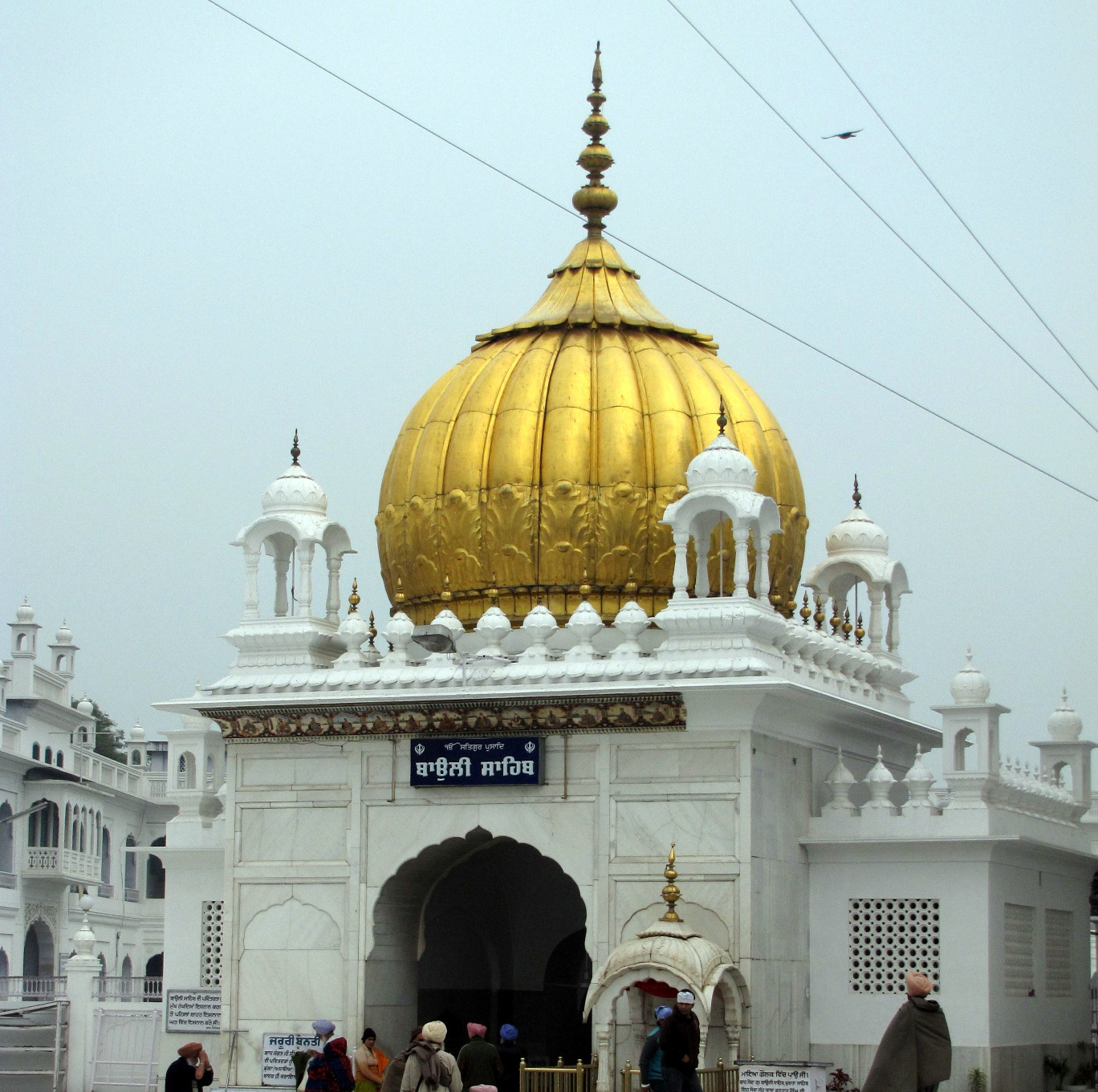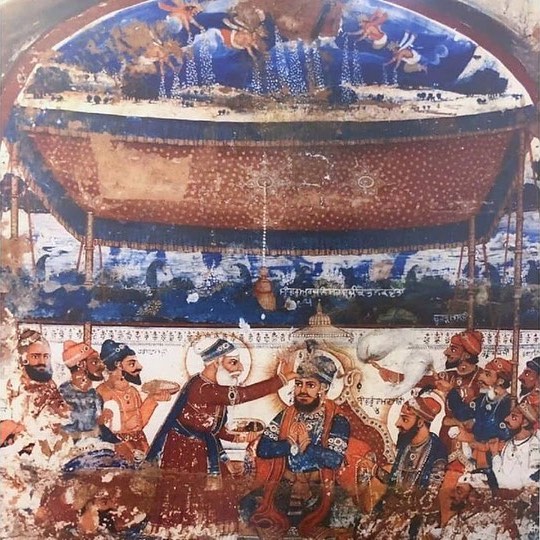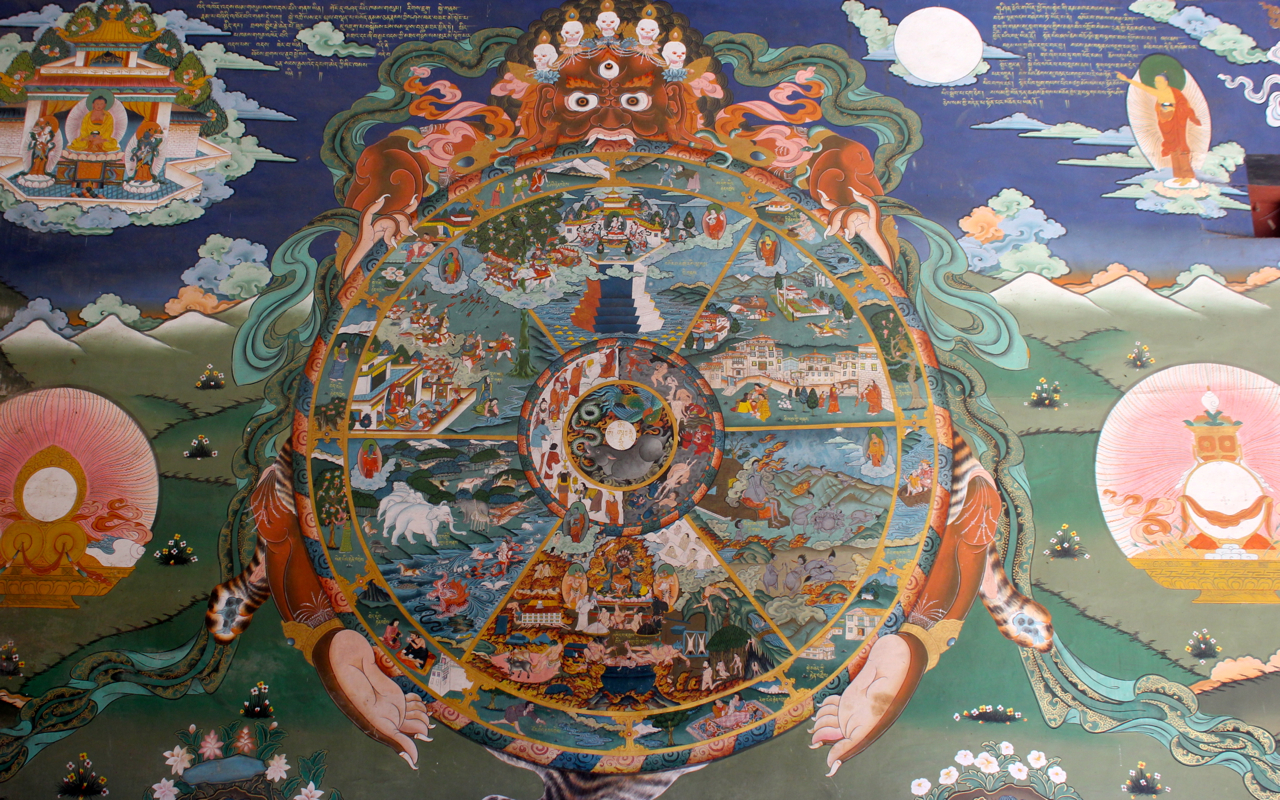|
Goindval
Goindwal ( pa, ਗੋਇੰਦਵਾਲ, meaning ‘City of Govind’, an epithet of God), also known as Goindwal Sahib and alternatively transliterated as Goindval, is located in Taran Taran district in the Majha region of the state of Punjab in India about 23 km from Tarn Taran Sahib. In the 16th century it became an important center for the Sikh religion during the Guruship of the Guru Amar Das Ji. Goindwal is on the banks of the river Beas and is one of the focal points of small scale industries of Tarn Taran district. Guru Amar Das (the third Guru or the third Nanak) stayed in Goindwal for 33 years where he established a new centre for preaching Sikhism. A ''Baoli'' (stepwell), paved with 84 steps was constructed there. Sikh’s believe that by reciting Japji Sahib, the divine ''Word'' revealed to Guru Nanak, at each of the 84 steps after taking a bath in the Baoli provides Moksha, liberation from 84,00,000 cycles of life of this world and unity with God (mukhti). Goindv ... [...More Info...] [...Related Items...] OR: [Wikipedia] [Google] [Baidu] |
Guru Arjan Dev Ji
Guru Arjan (Gurmukhi: ਗੁਰੂ ਅਰਜਨ, pronunciation: ; 15 April 1563 – 30 May 1606) was the first of the two Gurus martyred in the Sikh faith and the fifth of the ten total Sikh Gurus. He compiled the first official edition of the Sikh scripture called the Adi Granth, which later expanded into the Guru Granth Sahib. He was born in Goindval, in the Punjab, the youngest son of Bhai Jetha, who later became Guru Ram Das, and Mata Bhani, the daughter of Guru Amar Das. He completed the construction of Darbar Sahib at Amritsar, after the fourth Sikh Guru founded the town and built a sarovar. Guru Arjan compiled the hymns of previous Gurus and of other saints into Adi Granth, the first edition of the Sikh scripture, and installed it in the Harimandir Sahib. Guru Arjan reorganized the Masands system initiated by Guru Ram Das, by suggesting that the Sikhs donate, if possible, one-tenth of their income, goods or service to the Sikh organization (''dasvandh''). The ''Ma ... [...More Info...] [...Related Items...] OR: [Wikipedia] [Google] [Baidu] |
Khadur Sahib
Khadur Sahib is a town and a nagar panchayat in Tarn Taran district of Khadur Sahib tehsil of the Majha region of Indian state of Punjab. Khadur Sahib is a historical place in view of eight out of ten sikh gurus having visited this place. The postal index number of Khadur Sahib is 143117. History Khadur is a village associated with the second ''guru'' of the Sikhs, Guru Angad (1504–1552). He moved the early Sikh community's centre from Kartarpur to Khadur after becoming the guru after Nanak's passing and due to opposition from Nanak's sons. After Guru Angad passed, the community's headquarters was again moved by Guru Amar Das (1552–1574) to Goindval for similar reasons, them namely being challenges he faced from Angad's sons. Demographics As per 2011 Census of India The 2011 Census of India or the 15th Indian Census was conducted in two phases, house listing and population enumeration. The House listing phase began on 1 April 2010 and involved the collection ... [...More Info...] [...Related Items...] OR: [Wikipedia] [Google] [Baidu] |
Guru Amar Das Ji
Guru Amar Das (Gurmukhi: ਗੁਰੂ ਅਮਰ ਦਾਸ, pronunciation: ; 5 May 1479 – 1 September 1574), sometimes spelled as Guru Amardas, was the third of the Ten Gurus of Sikhism and became Sikh Guru on 26 March 1552 at age 73. Before becoming a Sikh (Shishya from Sanskrit), on a lovely pilgrimage after having been prompted to search for a ''guru'', he heard his nephew's wife, Bibi Amro, reciting a hymn by Guru Nanak, and was deeply moved by it. Bibi Amro was the daughter of Guru Angad, the second and then current Guru of the Sikhs. Amar Das persuaded Bibi Amro to introduce him to her father and in 1539, Amar Das, at the age of sixty, met Guru Angad and became a Sikh, devoting himself to the Guru. In 1552, before his death, Guru Angad appointed Amar Das as Guru Amar Das, the third Guru of Sikhism. Guru Amar Das was an important innovator in the teachings of Guru who introduced a religious organization called the Manji system by appointing trained clergy, a system th ... [...More Info...] [...Related Items...] OR: [Wikipedia] [Google] [Baidu] |
Guru Amar Das
Guru Amar Das (Gurmukhi: ਗੁਰੂ ਅਮਰ ਦਾਸ, pronunciation: ; 5 May 1479 – 1 September 1574), sometimes spelled as Guru Amardas, was the third of the Ten Gurus of Sikhism and became Sikh Guru on 26 March 1552 at age 73. Before becoming a Sikh (Shishya from Sanskrit), on a lovely pilgrimage after having been prompted to search for a ''guru'', he heard his nephew's wife, Bibi Amro, reciting a hymn by Guru Nanak, and was deeply moved by it. Bibi Amro was the daughter of Guru Angad, the second and then current Guru of the Sikhs. Amar Das persuaded Bibi Amro to introduce him to her father and in 1539, Amar Das, at the age of sixty, met Guru Angad and became a Sikh, devoting himself to the Guru. In 1552, before his death, Guru Angad appointed Amar Das as Guru Amar Das, the third Guru of Sikhism. Guru Amar Das was an important innovator in the teachings of Guru who introduced a religious organization called the Manji system by appointing trained clergy, a system th ... [...More Info...] [...Related Items...] OR: [Wikipedia] [Google] [Baidu] |
Bhai Gurdas
Bhai Gurdas ( pa, ਭਾਈ ਗੁਰਦਾਸ; 1551 – 25 August 1636) was a Sikh writer, historian and preacher who served as the Jathedar of the Akal Takht from 1606 to his death in 1636. He was the original scribe of the early version of Guru Granth Sahib. Early life Bhai Gurdas was possibly born in 1551 (exact year unknown but likely between 1543-1553) at Basarke Gillan, a small village in the Punjab. He was the only child of Bhai Ishar Das, nephew of Guru Amar Das, and Mata Jivani. Bhai Gurdas was near 3 years of age when his mother died. Bhai GURDAS (1551-1636) - SikhHistory.com After being orphaned at the age of 12, he was adopted by Guru Amar Das. Bhai Gurdas learned , ... [...More Info...] [...Related Items...] OR: [Wikipedia] [Google] [Baidu] |
Guru Angad Dev Ji
Guru Angad (31 March 1504 – 29 March 1552; Gurmukhi: ਗੁਰੂ ਅੰਗਦ, pronunciation: ) was the second of the ten Sikh gurus of Sikhism. After meeting Guru Nanak, the founder of Sikhism, becoming a Sikh, and serving and working with Guru Nanak for many years, Guru Nanak gave Lehna the name Angad ("my own limb"), and chose Angad as the second Sikh Guru. After the death of Guru Nanak in 1539, Guru Angad led the Sikh tradition. He is remembered in Sikhism for adopting and formalising the Gurmukhi alphabet. He began the process of compiling the hymns of Guru Nanak and contributed 62 or 63 hymns of his own. Instead of his own son, he chose his disciple Amar Das as his successor and the third Guru of Sikhism. Biography Early life Guru Angad was born with birth name of Lehna (also transliterated as Lahina) in village of Harike (other sources state his birthplace as Khadur) in the Punjab region. He was the son of a small but successful trader named Pheru Mal. His mother's n ... [...More Info...] [...Related Items...] OR: [Wikipedia] [Google] [Baidu] |
Tarn Taran District
Tarn Taran district is one of the districts in the Majha region of Punjab, India. The main cities are Tarn Taran Sahib, Bhikhiwind, Khadur Sahib and Patti. The City of Tarn Taran is a holy place for Sikhs. Tarn Taran district was formed in 2006 out of Amritsar District. The declaration to this effect was made by Captain Amarinder Singh, Chief Minister of Punjab, during the celebrations marking the martyrdom day of Sri Guru Arjan Dev Ji. With this, it became the 19th district of Punjab. It has four tehsils, which are Bhikhiwind, Patti, Khadur Sahib and Tarn Taran. The District Headquarters is headed by the Deputy Commissioner, along with a Senior Superintendent of Police, the Additional District and Sessions Judge, the Chief Judicial Magistrate, Civil Surgeon, district Education Officer, Improvement Trust and a Municipal Council. Demographics According to the 2011 census Tarn Taran district has a population of 1,119,627, roughly equal to the nation of Cyprus or the US state o ... [...More Info...] [...Related Items...] OR: [Wikipedia] [Google] [Baidu] |
Taran Taran District
Tarn Taran district is one of the districts in the Majha region of Punjab, India. The main cities are Tarn Taran Sahib, Bhikhiwind, Khadur Sahib and Patti. The City of Tarn Taran is a holy place for Sikhs. Tarn Taran district was formed in 2006 out of Amritsar District. The declaration to this effect was made by Captain Amarinder Singh, Chief Minister of Punjab, during the celebrations marking the martyrdom day of Sri Guru Arjan Dev Ji. With this, it became the 19th district of Punjab. It has four tehsils, which are Bhikhiwind, Patti, Khadur Sahib and Tarn Taran. The District Headquarters is headed by the Deputy Commissioner, along with a Senior Superintendent of Police, the Additional District and Sessions Judge, the Chief Judicial Magistrate, Civil Surgeon, district Education Officer, Improvement Trust and a Municipal Council. Demographics According to the 2011 census Tarn Taran district has a population of 1,119,627, roughly equal to the nation of Cyprus or the US state of ... [...More Info...] [...Related Items...] OR: [Wikipedia] [Google] [Baidu] |
Langar (Sikhism)
In Sikhism, a langar ( pa, ਲੰਗਰ, 'kitchen'Pashaura Singh, Louis E. Fenech, 2014The Oxford Handbook of Sikh Studies/ref>) is the community kitchen of a gurdwara, which serves meals to all free of charge, regardless of religion, caste, gender, economic status, or ethnicity. People sit on the floor and eat together, and the kitchen is maintained and serviced by Sikh community volunteers. The meals served at a langar are always lacto-vegetarian. Etymology ''Langar'' is a Persian word that was eventually incorporated into the Punjabi language and lexicon. Origins Concept of charity and providing cooked meals or uncooked raw material to ascetics and wandering yogis has been known in eastern cultures for over 2000 years. However, in spite of institutional support from several kings and emperors of the Delhi sultanate (up to the Mughal empire), it could not be institutionalized into a sustainable community kitchen, but continued as volunteer-run free food opportunities. Suc ... [...More Info...] [...Related Items...] OR: [Wikipedia] [Google] [Baidu] |
Vaisakhi
Vaisakhi ( Punjabi: ), also pronounced Baisakhi, marks the first day of the month of Vaisakh and is traditionally celebrated annually on 13 April and sometimes 14 April as a celebration of spring harvest primarily in Northern India. Further, other Indian cultures and diaspora celebrate this festival too. Whilst it is culturally significant as a festival of harvest, in many parts of India, Vaisakhi is also the date for the Indian Solar New Year. For Sikhs, in addition to its significance as the harvest festival, during which Sikhs hold kirtans, visit local Gurdwaras, community fairs, hold ''nagar kirtan'' processions, raise the Nishan Sahib flag, and gather to socialize and share festive foods, Vaisakhi observes major events in the history of Sikhism and the Indian subcontinent that happened in the Punjab region. Vaisakhi as a major Sikh festival marks the birth of the Khalsa order by Guru Gobind Singh, the tenth Guru of Sikhism, on 13 April 1699. Later, Ranjit Singh was procla ... [...More Info...] [...Related Items...] OR: [Wikipedia] [Google] [Baidu] |
Sati (practice)
Sati or suttee is a Hindu practice, now largely historical, in which a widow sacrifices herself by sitting atop her deceased husband's funeral pyre. Quote: Between 1943 and 1987, some thirty women in Rajasthan (twenty-eight, according to official statistics) immolated themselves on their husband's funeral pyre. This figure probably falls short of the actual number. (p. 182) Although it is debated whether it received scriptural mention in early Hinduism, it has been linked to related Hindu practices in the Indo-Aryan speaking regions of India which diminished the rights of women, especially those to the inheritance of property. A cold form of sati, or the neglect and casting out of Hindu widows has been prevalent in India from ancient times. Quote: Sati is a particularly relevant social practice because it is often used as a means to prevent inheritance of property by widows. In parallel, widows are also sometimes branded as witches – and subjected to violent expulsion fr ... [...More Info...] [...Related Items...] OR: [Wikipedia] [Google] [Baidu] |
Saṃsāra
''Saṃsāra'' (Devanagari: संसार) is a Pali/Sanskrit word that means "world". It is also the concept of rebirth and "cyclicality of all life, matter, existence", a fundamental belief of most Indian religions. Popularly, it is the cycle of death and rebirth. ''Saṃsāra'' is sometimes referred to with terms or phrases such as transmigration/reincarnation, karmic cycle, or Punarjanman, and "cycle of aimless drifting, wandering or mundane existence". The concept of ''saṃsāra'' has roots in the post-Vedic literature; the theory is not discussed in the Vedas themselves. It appears in developed form, but without mechanistic details, in the early Upanishads. The full exposition of the ''saṃsāra'' doctrine is found in Śramaṇic movements such as early Buddhism and Jainism, as well as various schools of Hindu philosophy after about the mid-1st millennium BCE. The ''saṃsāra'' doctrine is tied to the karma theory of Hinduism, and the liberation from ''saṃsāra ... [...More Info...] [...Related Items...] OR: [Wikipedia] [Google] [Baidu] |



.jpg)





